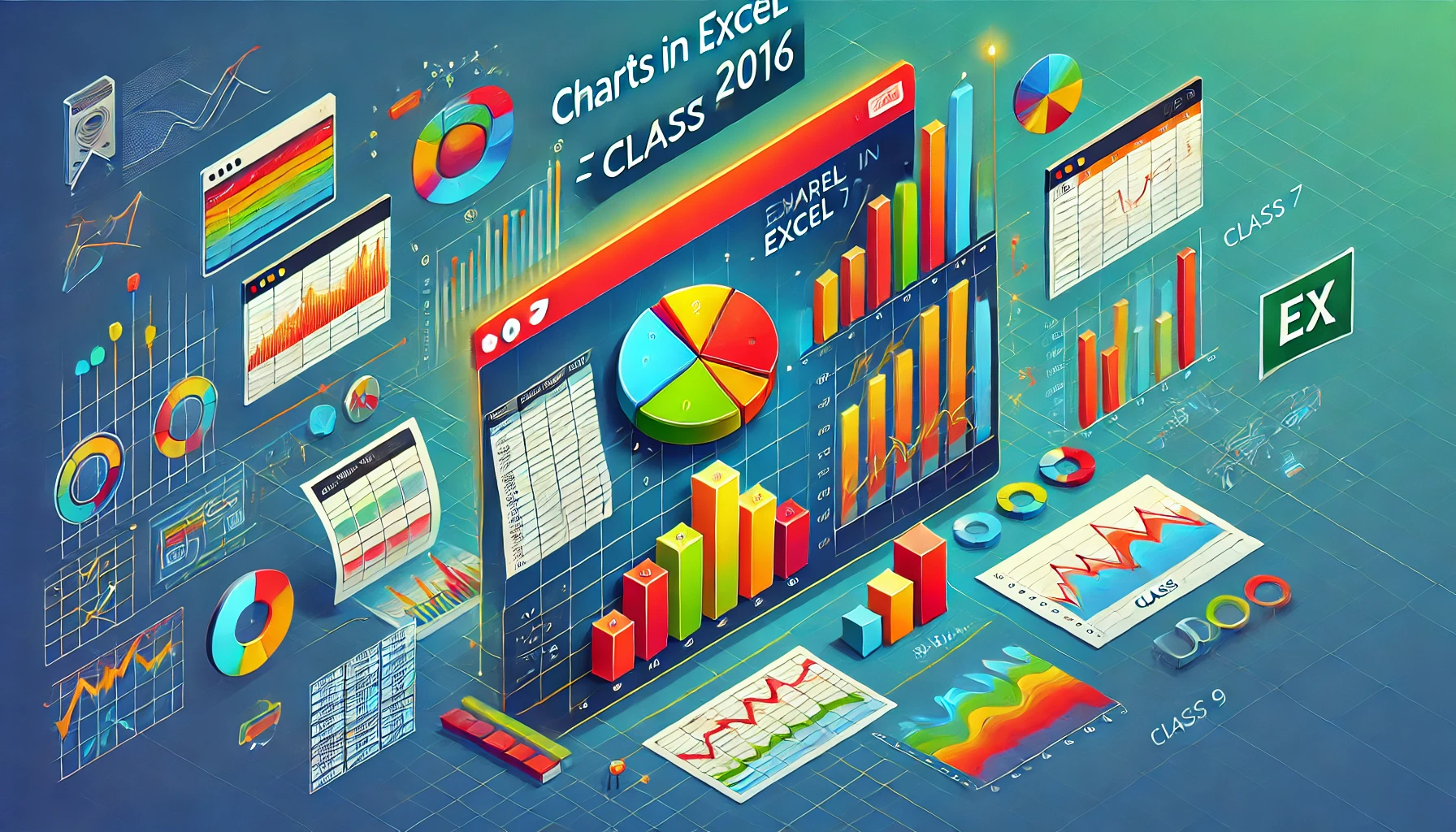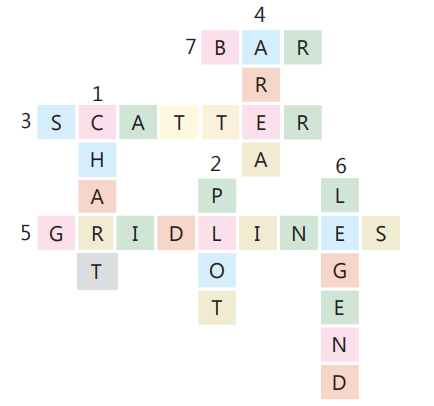Touchpad Computer Book Class 7 Ch 2 Solution Charts in Excel 2016
Chapter 2: Charts in Excel 2016 (Touchpad Computer Book Class 7)
Introduction to Charts in Excel 2016:
Charts in Excel 2016 help users visually represent numerical data for better analysis and understanding. They make data interpretation simpler and more insightful through various graphical representations.
Key Topics Covered:
1. Importance of Charts:
- Charts help in summarizing large amounts of data.
- They make data trends and patterns easier to understand.
2. Types of Charts in Excel 2016:
a) Column Chart:
- Used to compare values across categories.
- Example: Sales data over different months.
b) Line Chart:
- Best for showing trends over time.
- Example: Tracking monthly profits or website traffic.
c) Pie Chart:
- Represents data as a portion of the whole in a circular format.
- Example: Market share distribution among companies.
d) Bar Chart:
- Similar to a column chart but represented horizontally.
- Example: Comparing product ratings.
e) Area Chart:
- Similar to line charts but with the area below the lines filled.
- Example: Showing cumulative sales over a period.
f) Scatter Plot:
- Used to show relationships between two sets of data.
3. Creating a Chart in Excel 2016:
Steps to Create a Chart:
- Select the data range.
- Go to the Insert tab.
- Choose the desired chart type from the Charts group.
- Customize the chart using Chart Tools.
4. Chart Elements and Customization:
a) Chart Title:
- Add a meaningful title to the chart.
b) Axis Titles:
- Label the X-axis and Y-axis for clarity.
c) Data Labels:
- Display data values directly on the chart.
d) Legend:
- Helps identify data series in the chart.
e) Gridlines:
- Improve readability by aligning with data points.
5. Formatting Charts:
- Change chart styles using predefined templates.
- Modify chart colors, fonts, and design using the Format tab.
6. Saving and Printing Charts:
- Save charts by embedding them within the Excel sheet.
- Print charts using the File > Print option.
7. Practical Applications:
- Business reports
- School projects
- Data visualization in presentations
Summary:
Chapter 2 of the Touchpad Computer Book Class 7 provides essential knowledge of using charts in Excel 2016, covering chart types, creation steps, and customization techniques. Mastery of this topic enables students to represent data effectively and make insightful decisions.
Would you like me to prepare a detailed lesson plan or additional questions for this chapter?

Touchpad Computer Book Class 7 Ch 2 Solution Charts in Excel 2016
Let’s Catch up:

Ans: 1. Deepak 2. Anurag
Let’s Catch Up
Write the names of any four types of charts
- Scatter Chart
- Area Chart
- Bar Cart
- Pie Chart
TEST YOUR SKILLS
1. Tick() the correct option.
a. Which of the following is an effective way to display data in a pictorial form?
(i) Picture (ii) Chart
(iii) Table (iv) Graphics
Ans: (ii) Chart
b. Which of the following describes the main aim of the chart?
(i) Title bar (ii) Chart Title
(iii) Chart Description (iv) X-axis
Ans: (ii) Chart Title
c. ………………………….labels show information about a data series or its individual data points.
(i) Information (ii) Data
(iii) Axis (iv) Chart
Ans: (ii) Data
d. Which chart is used to show trends over a period of time?
(i) Column (ii) Line
(iii) Scatter (iv) Bar
Ans: (ii) Line
e. Which chart is used to display the quantitative magnitude of the data graphically?
(i) Bar (ii) Pie
(iii) Area (iv) Column
Ans: (iii) Area
2. Write ‘T’ for true and ‘F’ for false.
a. Data representation using charts is quite inefficient.
Ans: F
b. Y-axis of a chart is also known as the category axis.
Ans: F
c. Chart area includes all objects and elements in a chart.
Ans: T
d. Scatter chart is also known a XY scatter plot charts.
Ans: T
e. We cannot create Bar chart in Excel.
Ans: F
3. Fill in the blanks using the words from the help box.
(Gridlines, Chart, Legend, Column, Pie)
α. ………………………….is used to draw comparisons and analyze the growth and trends among the values in a table.
Ans: Chart
b. …………………………… can be either horizontal or vertical lines.
Ans: Gridlines
c. ……………………….. shows the meaning of symbols and colors used in a chart.
Ans: Legend
d. The ……………………. chart usually displays the data in the form of vertical bars.
Ans: Column
e. ……………………………. chart shows only one data series at a time.
Ans: Pie
4. Match the columns.
Column A Column B
a. Area chart (i) Trends over a period of time
b. Pie chart (ii) Quantitative magnitude of data
c. XY Scatter Plot Chart (iii) Sector showing relative size of each other
d. Line chart (iv) Correlation between two sets of values
Ans: a. (ii), b. (iii), c. (iv), d. (i)
5. Short answer type questions.
a. What is a chart? Explain briefly.
Ans: A chart is an effective way to display data in a pictorial form. It makes it easier to draw comparison and analyze the growth, relationship, and trends among the values in table.
b. Define legend.
Ans: Legend is a key that shows the meanings of symbols and colours used in the chart
c. What is Bar chart?
Ans: Bar chart displays the data in the form of long rectangular rods, also called bars.
d. What is Area chart?
Ans: Area chart is used to display the quantitative magnitude of the data graphically.
6. Lang answers type questions.
a. What are the differences between a line chart and an XY scatter chart?
Ans: Line Chart: It is used to show trends over a period of time. It is similar to plotting a graph on a graph paper with its values on X and Y axis. It uses connecting dots to display trends of a data over a given period of time. Whereas Scatter charts are also known as XY scatter plot charts. They show the correlation between the two sets of values. The x and y axes are used to represent the data plots on the chart.
b. Explain any 5 components of a chart.
Ans: The five components of charts are as follows:
Data Series: It is related to the set of values. It is represented by the bars or slices that represent the data values.
Data Labels: It include data values, category name, series name, legend keys and values from cells.
Gridlines: These can be either horizontal or vertical lines depending on the selected chart type. It makes it easier to read and understand the values.
Legend: It is a key that shows the meanings of symbols and colours used in the chart.
Chart Area: It includes all the objects and elements of a chart.
c. Write the steps to change the chart type.
Ans: Follow these steps to change the chart type:
Step 1: Select the chart.
Step 2: Click on the Change Chart Type command from Type group under the Design tab.
Step 3: Click on Line from the left panel of the Change Chart Type dialog box.
Step 4: Click on Line with Markers option from the right panel under Line group.
The chart will change to Line Chart.
FUN ZONE
LET’S SOLVE
1. Application-based question.
Suman wants to present the information in the form of a chart. She has a data of single series and the graph must show relative circular size of each value. Which chart type must she use?
Ans: Pie Chart
2. Solve the crossword using the clues.
Down:
1. It helps us to represent data pictorially.
2. This contains the actual chart and its other components.
4. These charts emphasize the area between the lines using colors and textures.
6. It contains the description of all the symbols used in a chart.
Across:
3. These are also known as XY plot charts.
5. These are horizontal or vertical lines.
7. These charts represent data in the form of long rods.
